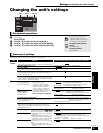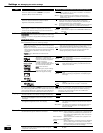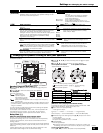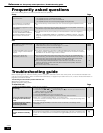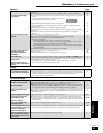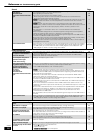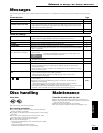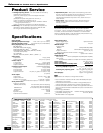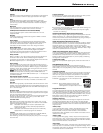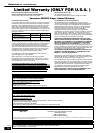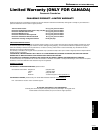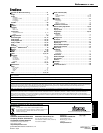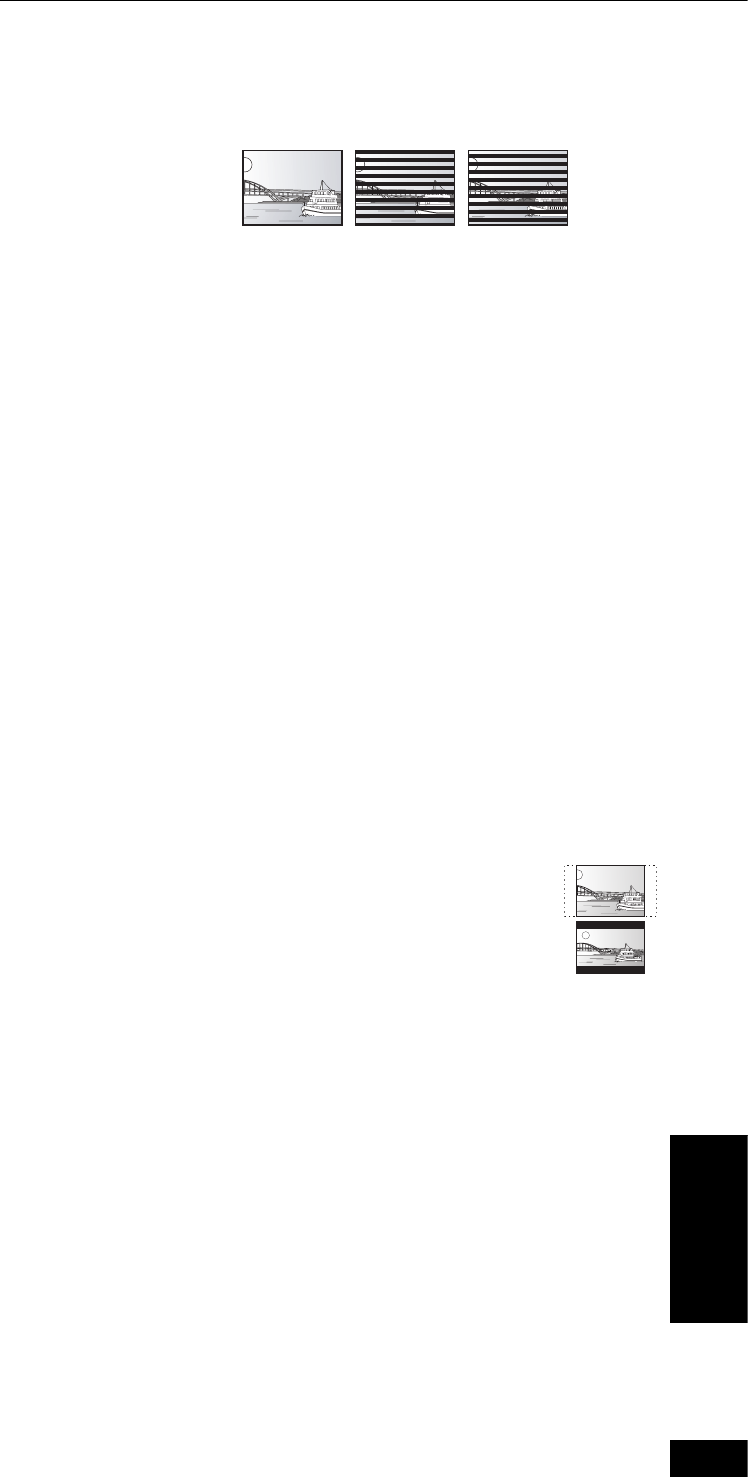
29
RQT8997
Glossary
AVCHD
AVCHD is a new format (standard) for high definition video cameras
that can be used to record and play high-resolution HD images.
BD-J
Some BD-Video discs contain Java applications, and these
applications are called BD-J. Depending on the BD-J application,
you can enjoy various interactive features in addition to playing
normal video.
Bitstream
This is the digital form of multi-channel audio data (e.g., 5.1
channel) before it is decoded into its various channels.
CPPM (Content Protection for Prerecorded Media)
A copy protection system used for DVD-Audio files. This unit
supports CPPM.
Decoder
A decoder restores the coded audio signals on DVDs to normal.
This is called decoding.
Dolby Digital
This is a method of coding digital signals developed by Dolby
Laboratories. Apart from stereo (2-channel) audio, these signals
can also be multi-channel audio. A large amount of audio
information can be recorded on one disc using this method.
Dolby Digital Plus
Multi-channel audio and higher audio quality is made possible
using Dolby Digital Plus. Previous Dolby Digital-compatible
equipment can play Dolby Digital Plus as Dolby Digital surround
audio. BD-Video supports up to 7.1 channel output.
Dolby TrueHD
Dolby TrueHD is a very high quality audio format that reproduces
the studio master audio. Previous Dolby Digital-compatible
equipment can play Dolby TrueHD as Dolby Digital surround audio.
BD-Video supports up to 7.1 channel output.
Down-mixing
This is the process of remixing the multi-channel audio found on
some discs into two channels. It is useful when you want to listen to
the 5.1-channel audio recorded on DVDs through your television’s
speakers. Some discs prohibit down-mixing and this unit can then
only output the front two channels.
[DVD-A] Tracks that do not allow down-mixing will not play correctly
on this unit except when connecting with an HDMI cable to an
amplifier/receiver that meets HDMI standards (ver. 1.1 or later) and
is CPPM compatible.
DTS (Digital Theater Systems)
This surround system is used in many movie theaters. There is good
separation between the channels, so realistic sound effects are
possible.
DTS-HD
DTS-HD is a high-quality, sophisticated audio format used in movie
theaters. Previous DTS Digital Surround-compatible equipment can
play DTS-HD as DTS Digital Surround audio. BD-Video supports up
to 7.1 channel output.
Dynamic range
Dynamic range is the difference between the lowest level of sound
that can be heard above the noise of the equipment and the highest
level of sound before distortion occurs.
Dynamic range compression means reducing the gap between the
loudest and softest sounds. This means you can listen at low
volumes but still hear dialog clearly.
Film and video
DVD-Video are recorded using either film or video. This unit can
determine which type has been used, then uses the most suitable
method of progressive output.
Film: Recorded at 24 frames per second. (Recorded at 30
frames per second as well). Generally appropriate for
motion picture films.
Video: Recorded at 30 frames/60 fields per second. Generally
appropriate for TV drama programs or animation.
Finalize
A process that makes play of a recorded CD-R, CD-RW, DVD-R,
etc. possible on equipment that can play such media.
After finalizing, the disc becomes play-only and you can no longer
record or edit.
Frames and fields
Frames refer to the single images that constitute the video you see
on your television. Each frame consists of two fields.
pA frame still shows two fields, so there may be some blurring, but
picture quality is generally better.
pA field still shows less picture information so it may be rougher,
but there is no blurring.
HDCP(High-Bandwidth Digital Content Protection)
HDCP is a type of digital rights management developed for use with
HDMI connections, etc. HDCP was developed to protect digital
content and prevent unsecured transmissions by using a variety of
methods such as encryption and authentication.
HDMI (High-Definition Multimedia Interface)
HDMI is a digital interface for consumer electronic products. Unlike
conventional connections, it transmits uncompressed digital video
and audio signals on a single cable. This unit supports high-
definition video output [720p (750p), 1080i (1125i), 1080p (1125p)]
from HDMI AV OUT terminals. To enjoy high-definition video a high
definition compatible television is required.
JPEG (Joint Photographic Experts Group)
This is a system used for compressing/decoding color still pictures.
If you select JPEG as the storage system on digital cameras, etc.,
the data will be compressed to 1/10–1/100 of its original size. The
benefit of JPEG is less deterioration in picture quality considering
the degree of compression.
LPCM (Linear PCM)
These are uncompressed digital signals, similar to those found on
CDs.
MP3 (MPEG Audio Layer 3)
An audio compression method that compresses audio to
approximately one tenth of its size without any considerable loss of
audio quality. You can play MP3 you have recorded onto CD-R and
CD-RW.
Pan&Scan/Letterbox
In general, DVD-Video are produced with the intention that they be
viewed on a widescreen television (16:9 aspect ratio), so images
often don’t fit regular (4:3 aspect ratio) televisions. Two styles of
picture, “Pan & Scan” and “Letterbox”, deal with this problem.
Pan&Scan: The sides are cut off so the picture fills
the screen.
Letterbox: Black bands appear at the top and
bottom of the picture so the picture
itself appears in an aspect ratio of 16:9.
Progressive/Interlace
The video signal standard of NTSC has 480 interlaced (i) scan lines,
whereas progressive (p) scanning uses twice the number of scan
lines, and this is referred to as 480p. Using progressive output, you
can enjoy watching high resolution video recorded on disc, such as
DVD-Video. Please note that your television must be capable of
progressive output to enjoy progressive video.
Sampling frequency
Sampling is the process of converting the heights of sound wave
(analog signal) samples taken at set periods into digits (digital
encoding). Sampling frequency is the number of samples taken per
second, so larger numbers mean more faithful reproduction of the
original sound.
1080i (1125i)
In one high definition image, 1080 (1125) alternating scan lines
pass every 1/60
th
of a second to create an interlace image.
Because 1080i (1125i) more than doubles current television
broadcasts of 480i, the detail is much clearer and creates a more
realistic and rich image.
1080p (1125p)
In one high definition image, 1080 (1125) scan lines pass at the
same time every 1/60
th
of a second to create a progressive image.
Since progressive video does not alternate scan lines like interlace,
there is a minimal amount of screen flicker.
720p (750p)
In one high definition image, 720 (750) scan lines pass at the same
time every 1/60
th
of a second to create a progressive image. Since
progressive video does not alternate scan lines like interlace, there
is a minimal amount of screen flicker.
Frame Field Field
u
r
Reference Glossary
Reference



